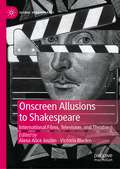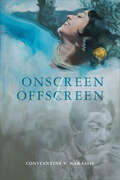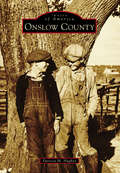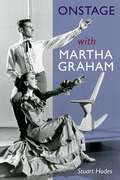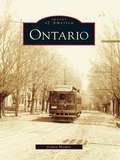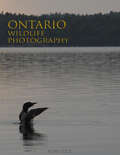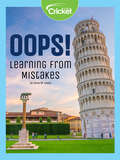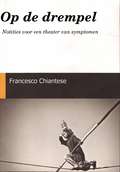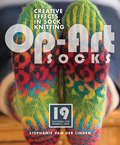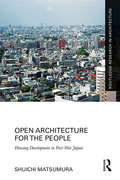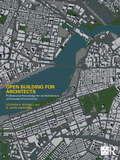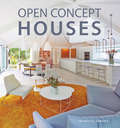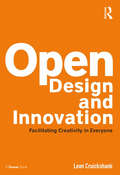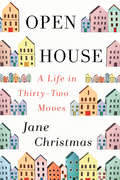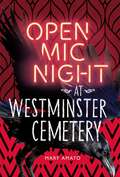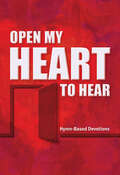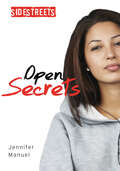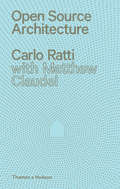- Table View
- List View
Onscreen Allusions to Shakespeare: International Films, Television, and Theatre (Global Shakespeares)
by Alexa Alice Joubin Victoria BladenAllusions to Shakespeare haunt our contemporary culture in a myriad of ways, whether through brief references or sustained intertextual engagements. Shakespeare’s plays and motifs have been appropriated in fragmentary forms onstage and onscreen since motion pictures were invented in 1893. This collection of essays extends beyond a US-UK axis to bring together an international group of scholars to explore Shakespearean appropriations in unexpected contexts in lesser-known films and television shows in India, Brazil, Russia, France, Australia, South Africa, East-Central Europe and Italy, with reference to some filmed stage works.
Onscreen/Offscreen (Studies in the Anthropology of Language, Sign, and Social Life)
by Constantine V. NakassisBased on over a decade of ethnographic fieldwork in the South Indian state of Tamil Nadu, Onscreen/Offscreen is an exploration of the politics and being of filmic images. The book examines contestations inside and outside the Tamil film industry over the question "what is an image?" Answers to this question may be found in the ontological politics that take place on film sets, in theatre halls, and in the social fabric of everyday life in South India, from populist electoral politics and the gendering of social space to caste uplift and domination. Bridging and synthesizing linguistic anthropology, film studies, visual studies, and media anthropology, Onscreen/Offscreen rethinks key issues across a number of fields concerned with the semiotic constitution of social life, from the performativity and ontology of images to questions of spectatorship, realism, and presence. In doing so, it offers both a challenge to any approach that would separate image from social context and a new vision for linguistic anthropology beyond the question of "language."
Onset and Point Independence (Postcard History)
by Michael J. MaddiganInaugurated in 1877 as a camp meeting ground by eastern Massachusetts residents who believed in communication with the dead, Onset quickly emerged as the nation's leading spiritualist summer community. By 1900, however, spiritualism had been overwhelmed by an influx of tourists, and Onset subsequently developed as a secular summer resort noted for its scenic bluffs, recreational pursuits, and beaches. At this same time, neighboring Point Independence found wide appeal among middle-class vacationers interested in swimming, sailing, and relaxation.
Onslow County (Images of America)
by Patricia M. HugheyOnslow County is one of the oldest maritime and agricultural counties on the southeastern coast of North Carolina. Originally inhabited by indigenous peoples, the area was settled in the early 18th century by a diverse group of people, including farmers, merchants, indentured servants, and slaves, hailing not only from nearby colonies but also from the British Isles and West Indies. This diversity has continued into the 21st century; Onslow's citizens have arrived from virtually every state and from several foreign countries due to the military presence of Camp Lejeune and New River Air Station. But there remains a nucleus population of families that descended from those early-18th-century pioneers--a thread that provides continuity into the present. These old-timers always appreciate and enjoy the history of their familiar surroundings, while newer residents want to learn more about the place they now call home.
Onstage with Martha Graham
by Stuart HodesWhen World War II was over, a young bomber pilot with an itch for movement and action hung up his cap and learned another way to fly. Onstage with Martha Graham is the story of Stuart Hodes, a versatile and influential dancer who got his start with Martha Graham, an icon of modern dance. His memoir is a rare firsthand view of the dance world in the 1940s and through the end of the twentieth century. One of the few male dancers in Graham’s company—and in the New York dance scene at the time—Hodes offers a unique perspective and a one-of-a-kind narrative. He describes how he fell into the art by chance, happening to walk into Graham’s studio one day. He was soon hooked. He documents his experiences, travels, passions, and loves while learning from and performing with Graham, during which time he saw most of the United States, much of Europe, and some of Asia. Advancing quickly, he eventually danced as Graham’s partner in Appalachian Spring, Deaths and Entrances, Every Soul Is a Circus, and Errand into the Maze. In his portrait of Martha Graham, who was the center of his dancing world, Hodes recounts conversations, revelations, bouts of temper and creativity, the daily ritual of deeply physical dancing, and the never-ending search for artistic validity. Direct, often humorous, and always authentic, Hodes shares his delight in dance as both hard work and a fantastic adventure.
Ontario
by Joann MeakerNestled in the northwest corner of Wayne County, Ontario takes its name from the lake on its northern border. Through some 200 compelling photographs, Ontario traces the historical influences that helped shape this town from apples to atoms--from the distantglacial past, the land developers Phelps and Gorham, the Iroquois Nation, and the early settlers to the major industries of iron ore mining and nuclear power. It focuses on the people, places, businesses,industries, and agriculture that earned the town its motto: the Community of Good Neighbors.
Ontario & Western Railway Northern Division, The
by John TaibiThe New York & Oswego Midland Railroad-reorganized in 1879 as the New York, Ontario & Western Railway-was born out of necessity and a desire to populate and industrialize the interior regions of New York State. The railroad meandered down from Oswego, traversed the north shore of Oneida Lake, and then took a southerly route through Oneida and Norwich before turning east for a mountainous crossing to gain the village of Sidney. The railroad was not a success in its time. The New York, Ontario & Western brought a degree of financial stability to the northern division, and the line functioned through the late 1950s.The Ontario & Western Railway Northern Division features photographs of the Ontario & Western, a railroad long on scenery but short on freight. The Ontario & Western inherited a railroad in search of revenue and a circuitous route that passed through one small community after another. Small wooden country depots dotted the line, locomotives of meager proportions pulled the trains, and dedicated employees did their best to keep the railroad solvent. The railroad is still fondly remembered today by those who rode its cars and witnessed its passing trains.
Ontario Wildlife Photography
by Noah ColeThis stunning collection of wildlife photography features moose, turtles, dragonflies, shorebirds, hawks, and songbirds from the marshlands of Point Pelee to the wilderness north of Lake Superior.Explore parks and trails where colourful birds and turtles live. Behold wetlands where moose browse. Delight in vibrant butterflies and bumblebees that pollinate wildflowers. Discover all this and so much more as you travel across the province through the pages of Ontario Wildlife Photography. From the Ottawa Valley and the Frontenac Arch in the east to the shores of Lake Huron in the west, and from areas north of Lake Superior to Canada’s southernmost destination on Lake Erie, Ontario Wildlife Photography immerses you in outstanding photography from an appealing array of locations. Learn why trout depend on healthy forests, the secrets of colourful salamanders, where to find shorebirds and herons, and so much more. This timeless book of acclaimed wildlife photographs inspires discovery and conservation and also makes a beautiful and meaningful gift.
Onward and Upward in the Garden
by Katharine S. WhiteMrs. White loved gardens and spent much time working in hers and writing about all things related. Her husband's introduction to this book is warm and informative.
Oops! Learning from Mistakes
by Anna M. LewisFor engineers and architects, mistakes are part of the creative process. Learn why the Leaning Tower of Pisa leans, how the reflections from the Walt Disney Concert Hall caused a heat ray, and what engineers and architects did to solve these types of problems.
Op de drempel
by Jannie Meijer Francesco ChianteseEen kort essay over theater van Francesco Chiantese met enkele notities over zijn eerste twintig jaar van theateronderzoek. In limine - Notities voor een theater van symptomen is een verzameling korte notities, bespiegelingen en vragen die Francesco Chiantese zichzelf heeft gesteld in de eerste twintig jaar van zijn leven met theater. Centraal in dit essay staat een gesprek met een van zijn leerlingen. De foto op het omslag is van Daniela Neri www.danielaneri.eu Kan theateronderzoek een nieuw "volkstheater" opleveren? Wat is het "bijgeloof van het begrip"? In welke relatie staat het onderzoek tot de theatertraditie? Kunnen we spreken van een "theater van symptomen"? Francesco Chiantese, theateronderzoeker en een van de velen die de "verborgen scene" van het Italiaanse theateronderzoek begeesteren, stelt deze vragen centraal in zijn bespiegelingen over theater. In limine is een kort essay waarin meer vragen, twijfels en vraagtekens aan bod komen dan antwoorden worden gegeven. Dit essay is geschreven als een flessenpost, in de hoop dat iemand het toevallig vindt en een dialoog wil starten. Genre: UITVOERENDE KUNSTEN / Theater / Algemeen
Op-Art Socks: Creative Effects in Sock Knitting
by Stephanie van der LindenEnjoy a fresh new approach to sock knitting! Stephanie van der Linden is a master knitter and shows her technical skills to great effect in Op-Art Socks. A collector of op-art ceramics, she was inspired to translate graphic optical illusions into knitted patterns for socks, replicating their eye-popping effects. Op-Art Socks contains 19 projects. Explore graphic colorwork, textured knitting (knit and purl), shadow knitting, and shifting ribbing to create optical illusions. The book includes black and white swatches of all patterns so that you can readily perceive the op-art illusions in each piece. Op-Art Socks is truly unique in theme and designs. Go beyond ordinary sock knitting into new territory!
Open Architecture for the People: Housing Development in Post-War Japan (Routledge Research in Architecture)
by Shuichi MatsumuraOpen Architecture for the People explores Japanese architecture and the three different phases of development between the years 1950 and 2018. Changing ways of life through differing generations have caused fluctuations in the building industry. This book demonstrates how each generation's expectations have resulted in discernible eras in architecture which can be examined collectively as well as in isolation. For example, the sudden increase in productivity from 1950 brought about by the Industrial Revolution flowed to the production of buildings and homes and designs were influenced by modern ideas. With over thirty black and white images to illustrate the changes, Matsumura brings to light architectural developments that have previously been confined to Japanese speaking academics. In doing so, the book broadens the scope for further architectural examinations internationally. It would be ideal for academics, students and professionals within the areas of architecture and urban planning, particularly those with an interest in Japanese architecture.
Open Building for Architects: Professional Knowledge for an Architecture of Everyday Environment (Open Building)
by N. John Habraken Stephen H. KendallOpen Building is an internationally recognized approach to the design of buildings and building complexes with roots in the way the ordinary built environment grows and regenerates. The Open Building approach recognizes that both stability and change are realities to be managed in the contemporary built environment. Buildings – and the neighborhoods they occupy – are not static during the most stable times or during times of rapid social and technical change. They are living organisms that need constant adjustments to remain attractive, safe and valuable. Using case studies of built projects from around the world, this book explains the Open Building approach and discusses important characteristics of everyday built environment that the Open Building approach designs for. It also presents a key method that can be used to put the approach into use. It addresses questions such as: • How can we design large projects for inevitable change? • How can we balance the demands of large projects for efficient implementation with the need for ‘fine-grained’ decision-making control? • How can we separate design tasks, one task being the design of what should last a century, the other task being the design of more mutable units of occupancy? • How can we identify and share architectural themes and, at the same time, make variations on them? • How can we use the Open Building approach to steward the earth’s scarce resources and contribute to a circular economy that benefits all people? This book is an essential resource for practitioners, investors and developers, regulators, builders, product manufacturers and educators interested in why the Open Building approach matters and how to practice Open Building.
Open Building for Architects: Professional Knowledge for an Architecture of Everyday Environment (Open Building)
by N. John Habraken Stephen H. KendallOpen Building is an internationally recognized approach to the design of buildings and building complexes with roots in the way the ordinary built environment grows and regenerates. The Open Building approach recognizes that both stability and change are realities to be managed in the contemporary built environment. Buildings – and the neighborhoods they occupy – are not static during the most stable times or during times of rapid social and technical change. They are living organisms that need constant adjustments to remain attractive, safe and valuable.Using case studies of built projects from around the world, this book explains the Open Building approach and discusses important characteristics of everyday built environment that the Open Building approach designs for. It also presents a key method that can be used to put the approach into use. It addresses questions such as: How can we design large projects for inevitable change? How can we balance the demands of large projects for efficient implementation with the need for ‘fine-grained’ decision-making control? How can we separate design tasks, one task being the design of what should last a century, the other task being the design of more mutable units of occupancy? How can we identify and share architectural themes and, at the same time, make variations on them? How can we use the Open Building approach to steward the earth’s scarce resources and contribute to a circular economy that benefits all people? This book is an essential resource for practitioners, investors and developers, regulators, builders, product manufacturers and educators interested in why the Open Building approach matters and how to practice Open Building.
Open Circuits: The Inner Beauty of Electronic Components
by Windell Oskay Eric SchlaepferOpen Circuits is a photographic exploration of the beautiful design inside everyday electronics. Its stunning cross-section photography unlocks a hidden world full of elegance, subtle complexity, and wonder.Our phones, computers, and appliances are made of hundreds of internal components, each precisely engineered to perform a certain function, but none intended to actually be seen. Through painstakingly executed, vividly detailed cross-section photography, Open Circuits reveals the surprising—and often accidental—beauty hiding inside the electronic components that drive our everyday devices. From resistors to LEDs, USB cables to headphone jacks, stepper motors to nixie tubes, the book&’s arresting imagery transforms more than 130 components into delightful works of art. As you visually dissect the components&’ insides, you&’ll learn about how they work and how they were made. Open Circuits has something for everyone to appreciate, whether you&’re a seasoned electrical engineer, an amateur tinkerer, or simply a lover of art and photography.
Open Concept Houses
by Francesc ZamoraFrom the author of the successful 150 Best series comes the debut entry in the forward-thinking Open Concept Houses series, filled with nearly 500 pages of color photos—sure to become the ultimate resource for this fast-growing trend in home design and renovation.One of the hottest lifestyle trends today, open concept living spaces eliminate doorways and walls to create a large combined area for cooking, dining, entertaining, and relaxing. No longer are the kitchen, dining room, and living room compartmentalized. Instead, each space blends into the next to create one large area "separated" and defined by islands, carpets, and furniture. This increasingly popular style provides a sense of expansiveness, connectedness, and flow that traditional architecture and design—defined by spaces broken by walls—lack.This engaging, inspiring, and informative volume brings together a diverse collection of houses from all over the world, including spaces that have been designed from the ground up or have been renovated to reflect this popular trend. Inside Open Concept Houses you’ll find an array of beautiful and creative homes by distinguished international architects and designers who have conceived practical and functional solutions adapted to the specific needs and particular tastes of their clients.Filled with hundreds of full-color photographs as well as sets of floorplans for renovated residences—both the original and remodeled blueprints—this imaginative, idea-filled book is a must-have for architects, designers, decorators, and home owners looking to create or adapt the open concept style in their own dwellings.
Open Design and Innovation: Facilitating Creativity in Everyone
by Leon CruickshankOpen innovation, crowd sourcing, democratised innovation, vernacular design and brand fanaticism are amongst a handful of new approaches to design and innovation that have generated discussion and media coverage in recent years. In practice, these ideas are often inspiring propositions rather than providing pragmatic strategies. Open Design and Innovation develops the argument for a more nuanced acknowledgement and facilitation of 'non-professional' forms of creativity; drawing on lessons from commercial design practice; theoretical analysis and a wider understanding of innovation. Specifically this book examines: innovation and design, the reality and myth of mass creativity and the future of the design profession, through a series of case studies of new approaches to open design practices. The text draws on academic research, practical experience of the author in delivering open design projects and first hand interviews with leaders in the fields. The author challenges the notion of the designer as 'fountain-head' of innovation and, equally, the idea of 'user creativity' as a replacement for traditional design and innovation. The book offers a critique of the hype surrounding some of the emerging phenomena and a framework to help understand the emerging relationship between citizens and designers. It goes on to propose a roadmap for the development of the design profession, welcoming and facilitating new modes of design activity where designers facilitate creative collaborations.
Open House: A Life in 32 Moves
by Jane ChristmasMoving house has never flustered author Jane Christmas. She loves houses: viewing them, negotiating their price, dreaming up interior plans, hiring tradespeople to do the work and overseeing renovations. She loves houses so much that she’s moved thirty-two times.There are good reasons for her latest house move, but after viewing sixty homes, Jane and her husband succumb to the emotional fatigue of an overheated English housing market and buy a wreck in the town of Bristol that is overpriced, will require more money to renovate than they have and that neither of them particularly like.As Jane’s nightmare renovation begins, her mind returns to the Canadian homes where she grew up with parents who moved and renovated constantly around the Toronto area. Suddenly, the protective seal is blown off Jane’s memory of a strict and peripatetic childhood and its ancillary damage—lost friends, divorces, suicide attempts—and the past threatens to shake the foundations of her marriage. This latest renovation dredges a deeper current of memory, causing Jane to question whether in renovating a house she is in fact attempting to renovate her past.With humour and irreverence, Open House reveals that what we think we gain by constantly moving house actually obscures the precious and vital parts of our lives that we leave behind. This is a memoir that will appeal to anyone whose pulse quickens at the mere mention of real estate.
Open Letters
by Alison RowleyDuring the fin-de-siècle and early revolutionary eras, picture postcards were an important medium of communication for Russians of all backgrounds. In Open Letters, the most comprehensive study of Russian picture postcards to date, Alison Rowley uses this medium to explore a variety of aspects of Russian popular culture. The book is lavishly illustrated with more than 130 images, most of which have never been published before.Through her examinations of postcards, Rowley addresses a diverse range of topics: how landscape postcards conveyed notions of imperialism; the role of postcards in the rise of celebrity culture; depictions of the body on erotic and pornographic postcards; how postcards were employed to promote differing interpretations of the First World War; and the use of postcards by revolutionary groups seeking to overthrow the Tsarist government. Rowley determines the extent to which Russia was embedded in Europe-wide cultural trends by situating the Russian case within a larger European context.
Open Mic Night at Westminster Cemetery
by Mary AmatoWhen Lacy wakes up dead in Westminster Cemetery, final resting place of Edgar Allan Poe, she's confused. It's the job of Sam, a young soldier who died in 1865, to teach her the rules of the afterlife and to warn her about Suppression—a punishment worse than death. Lacy desperately wants to leave the cemetery and find out how she died, but every soul is obligated to perform a job. Given the task of providing entertainment, Lacy proposes an open mic, which becomes a chance for the cemetery's residents to express themselves. But Lacy is in for another shock when surprising and long-buried truths begin to emerge.
Open My Heart to Hear: Hymn-Based Devotions
by Northwestern Publishing HouseDive deeper into the beauty of time-treasured and new favorite worship songs in this collection of hymn-based devotions!Open My Heart to Hear is an opportunity to meditate on the words of beloved hymns and marvel at how they point you to the amazing nature of God's love for you. From "Savior of the Nations," "Come," and "When I Survey the Wondrous Cross," to "Christ Is with Me" and "Do Not Let Your Hearts Be Troubled," hymns both familiar and new form the foundation for the faith-strengthening truths expressed in these 90 brief devotions based on hymns from Christian Worship: Hymnal. Explore the riches of God's grace in each hymn's poetry in this collection of devotions and pray alongside the hymn writer: "Lord, open now my heart to hear, and through your Word to me draw near"
Open Secrets (Lorimer SideStreets)
by Jennifer ManuelSeventeen-year-old Ana Santos has ambitions to make it big in music. When she signs a contract with the owner of a music café, she has no idea there are sexual strings attached. This book looks at the darker side of the music industry, including sexual harassment, lyrics that degrade and demean women, and social media trolling as backlash for speaking up. Ana is a strong, realistic main character who overcomes her feelings of shame to find a voice for herself and her music. The #MeToo movement has revealed the prevalence of sexual assault in society, and an issue that also affects the lives of teen girls. Distributed in the U.S by Lerner Publishing Group
Open Source Architecture
by Carlo Ratti Matthew ClaudelA provocative look at the architecture of the future and the challenges of learning from the past Open Source Architecture is a visionary manifesto for the architecture of tomorrow that argues for a paradigm shift from architecture as a means of supporting the ego-fueled grand visions of "starchitects" to a collaborative, inclusive, network-driven process inspired by twenty-first-century trends such as crowd-sourcing, open access, and mass customization. The question is how collaborative design can avoid becoming design-by-committee. Authors Carlo Ratti and Matthew Claudel navigate this topic nimbly in chapters such as "Why It Did Not Work" and "Learning from the Network." They also meet the essential requirement of any manifesto, considering the applications of open-source architecture not only conceptually but also in practice, in chapters such as "Open Source Gets Physical" and "Building Harmonies." Open Source Architecture is an important new work on the frontlines of architectural thought and practice.
Open Space New Media Documentary: A Toolkit for Theory and Practice (Routledge Studies in Media Theory and Practice)
by Patricia R. Zimmermann Helen De MichielOpen Space New Media Documentary examines an emerging and significant area of documentary practice in the twenty-first century: community-based new media documentary projects that move across platforms and utilize participatory modalities. The book offers an innovative theorization of these collaborative and collective new media practices, which the authors term "open space," gesturing towards a more contextual critical nexus of technology, form, histories, community, convenings, collaborations, and mobilities. It looks at a variety of low cost, sustainable and scalable documentary projects from across the globe, where new technologies meet places and people in Argentina, Canada, India, Indonesia, Peru, South Africa, Ukraine, and the USA.
